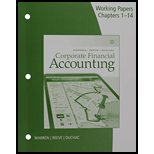
1.
Bonds: Bonds are long-term promissory notes that are represented by a company while borrowing money from investors to raise fund for financing the operations.
Bonds Payable: Bonds payable are referred to long-term debts of the business, issued to various lenders known as bondholders, generally in multiples of $1,000 per bond, to raise fund for financing the operations.
Premium on bonds payable: It occurs when the bonds are issued at a high price than the face value.
To prepare:
1.
Answer to Problem 11.2BPR
Prepare journal entry for cash proceeds from the issuance of the bonds on July 1, Year 1.
| Date | Account Title and Explanation | Post Ref | Debit ($) | Credit ($) | |||
| Year 1 | Cash | 73,100,469 | |||||
| July | 1 | Premium on Bonds Payable (1) | 8,100,469 | ||||
| Bonds Payable | 65,000,000 | ||||||
| (To record issue of bonds at premium) | |||||||
Table (1)
Explanation of Solution
- Cash is an asset and it is increased. So, debit it by $73,100,469.
- Premium on Bonds Payable is an adjunct liability account and it is increased. So, credit it by $8,100,469.
- Bonds payable is a liability and it is increased. So, credit it by $65,000,000.
Working note:
Calculate premium on bonds payable.
2.
A.
To prepare: Journal entry to record first semiannual interest payment and amortization of bond premium on December 31, Year 1.
2.
A.
Answer to Problem 11.2BPR
Prepare journal entry for first semiannual interest payment and amortization of discount on bonds.
| Date | Account Title and Explanation | Post Ref | Debit ($) | Credit ($) | |||
| Year 1 | Interest Expense (4) | 3,494,977 | |||||
| December | 31 | Premium on Bonds Payable (2) | 405,023 | ||||
| Cash (3) | 3,900,000 | ||||||
| (To record first semiannual payment of interest on bonds) | |||||||
Table (2)
Explanation of Solution
- Interest expense is an expense and it decreases the equity value. So, debit it by $3,494,977.
- Premium on Bonds Payable is an adjunct liability account and it is decreased. So, debit it by $405,023.
- Cash is an asset and it is decreased. So, credit it by $3,900,000.
Working notes:
Calculate premium on bonds payable semiannually.
Calculate the amount of cash interest.
Calculate the interest expense on the bond.
B.
To prepare: Journal entry to record second interest payment and amortization of bond discount on June 30, Year 2.
B.
Answer to Problem 11.2BPR
Prepare journal entry for second interest payment and amortization of discount on bonds.
| Date | Account Title and Explanation | Post Ref | Debit ($) | Credit ($) | |||
| Year 2 | Interest Expense (7) | 3,494,977 | |||||
| June | 30 | Premium on Bonds Payable (5) | 405,023 | ||||
| Cash (6) | 3,900,000 | ||||||
| (To record second semiannual payment of interest on bonds) | |||||||
Table (3)
Explanation of Solution
- Interest expense is an expense and it decreases the equity value. So, debit it by $3,494,977.
- Premium on Bonds Payable is an adjunct liability account and it is decreased. So, debit it by $405,023.
- Cash is an asset and it is decreased. So, credit it by $3,900,000.
Working notes:
Calculate premium on bonds payable semiannually.
Calculate the amount of cash interest.
Calculate the interest expense on the bond.
3.
The amount of total interest expense for Year 1.
3.
Explanation of Solution
Determine the amount of total interest expense for Year 1.
Hence, the amount of total interest expense for Year 1 is $3,494,977.
4.
To explain: The situation when contract rate of bond is greater than the market rate of interest.
4.
Answer to Problem 11.2BPR
Yes, the bond proceeds will always be greater than the face amount of bonds when the contract interest rate is greater than the market interest rate.
Explanation of Solution
If the stated interest rate of a bond is greater than the market interest rate, then the bonds is issued at premium. This is because the bond is more valuable in market and investors are ready to pay more than the maturity
5.
To calculate: The amount of cash proceeds (present value) from the sale of the bonds using present value tables.
5.
Explanation of Solution
Determine the amount of cash proceeds (present value) from the sale of the bonds.
Step 1: Calculate the semiannual interest on bonds.
Step 2: Calculate the present value of interest.
| Particulars | Amount |
| Interest payment (a) | $3,900,000 |
| PV factor at semiannual market interest rate of 5% for 20 periods (b) | 12.46221 |
| Present value
|
$48,602,619 |
Table (4)
Note: Refer Appendix A in the text book for present value factor.
Step 3: Calculate the present value of lump sum payment of $65,000,000 (principal amount) at 5% for 20 periods.
| Particulars | Amount |
| Single payment (a) | $65,000,000 |
| PV factor at semiannual market interest rate of 5% for 20 periods (b) | 0.37689 |
| Present value
|
$24,497,850 |
Table (5)
Note: Refer Appendix A in the text book for present value factor.
Step 4: Calculate the amount of cash proceeds from the sale of the bonds.
Thus, the amount of cash proceeds from the sale of the bonds is $73,100,469.
Want to see more full solutions like this?
Chapter 11 Solutions
Working Papers for Warren/Reeve/Duchac's Corporate Financial Accounting, 14th
 Excel Applications for Accounting PrinciplesAccountingISBN:9781111581565Author:Gaylord N. SmithPublisher:Cengage Learning
Excel Applications for Accounting PrinciplesAccountingISBN:9781111581565Author:Gaylord N. SmithPublisher:Cengage Learning College Accounting, Chapters 1-27AccountingISBN:9781337794756Author:HEINTZ, James A.Publisher:Cengage Learning,Principles of Accounting Volume 1AccountingISBN:9781947172685Author:OpenStaxPublisher:OpenStax College
College Accounting, Chapters 1-27AccountingISBN:9781337794756Author:HEINTZ, James A.Publisher:Cengage Learning,Principles of Accounting Volume 1AccountingISBN:9781947172685Author:OpenStaxPublisher:OpenStax College Financial AccountingAccountingISBN:9781305088436Author:Carl Warren, Jim Reeve, Jonathan DuchacPublisher:Cengage Learning
Financial AccountingAccountingISBN:9781305088436Author:Carl Warren, Jim Reeve, Jonathan DuchacPublisher:Cengage Learning Cornerstones of Financial AccountingAccountingISBN:9781337690881Author:Jay Rich, Jeff JonesPublisher:Cengage Learning
Cornerstones of Financial AccountingAccountingISBN:9781337690881Author:Jay Rich, Jeff JonesPublisher:Cengage Learning




